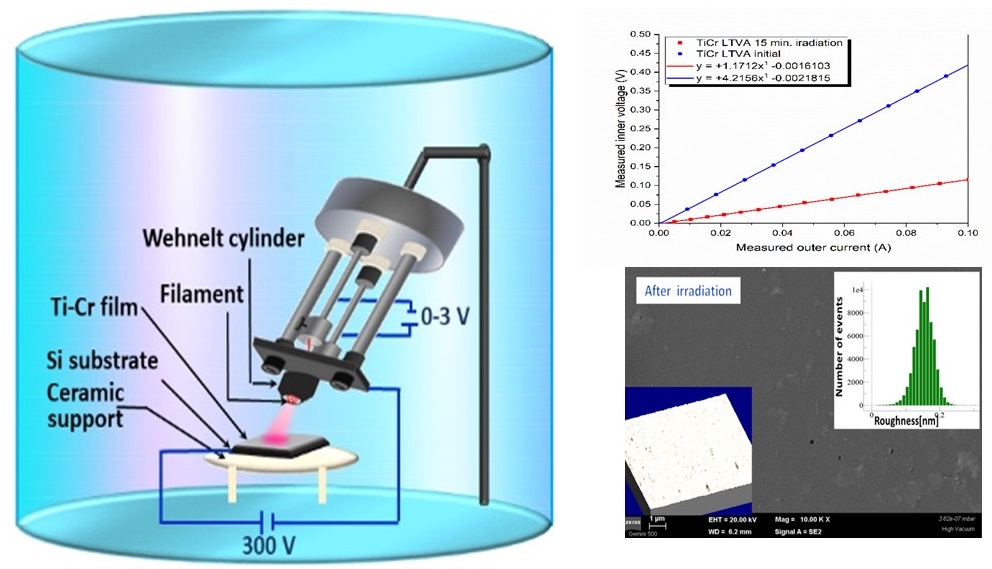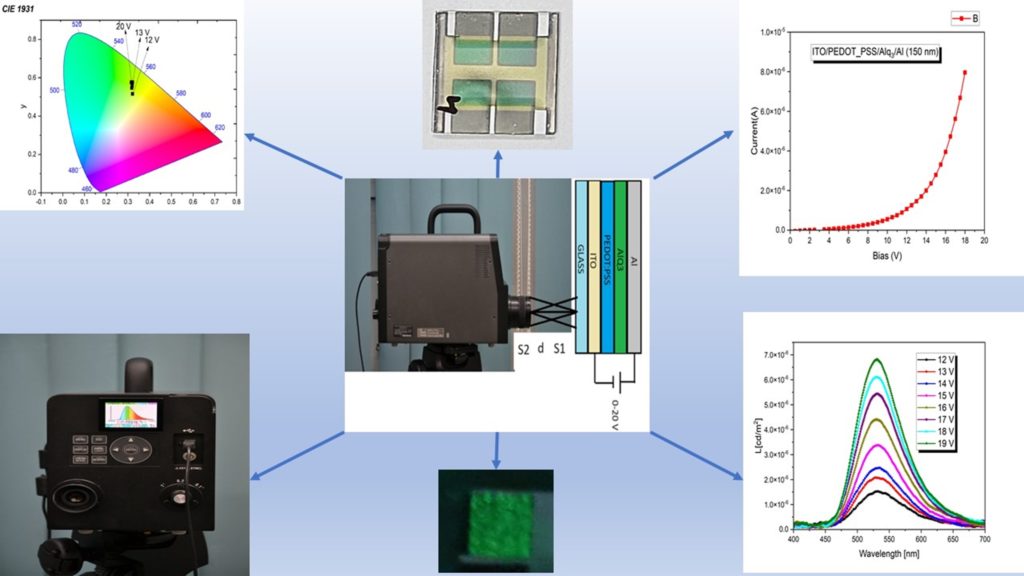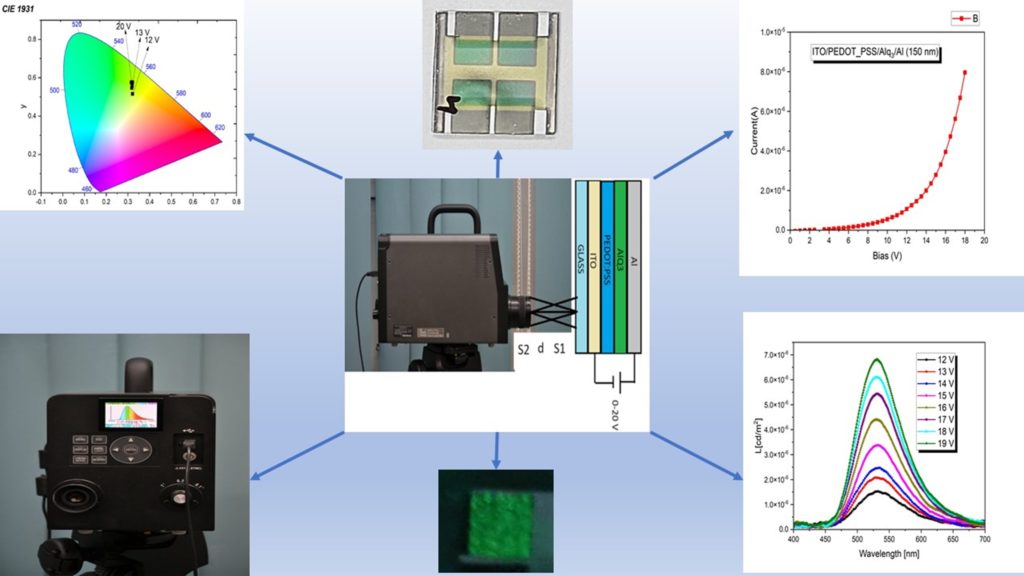Transparent metallic electrodes and conductors for Organic Electroluminescent Diodes
Project Director: Dr. Silviu POLOSAN
Project summary:
The project describes the manufacture of transparent metal electrodes for electroluminescent diodes, which allow the improvement of charge transport through multilayer OLED structures and the increase of light emission due to the electroluminescence obtained on both sides. As a novelty, the application of a patent based on low-energy electron irradiation of metal surfaces facilitates the obtaining of transparent anodes with improved electrical conductivity by decreasing the roughness, using the nanozonal melting of metal films under the action of an electron beam. Regarding the transparent cathodes, the project proposes a new strategy of electrodes with low mechanical extraction work, using alloys between alkaline-earth metals and metallic silver. Ag-Mg compositional optimization for cathodes with uniform distribution and optimal Ag/Mg ratio represents the second novelty of this project. This fact implies obtaining thin films as good quality alloys using thermal co-evaporation and comparing them with those obtained by vacuum thermionic arc deposition.
Objectives:
1. Depositing thin silver films by the thermionic arc method and thermal evaporation in a vacuum.
2. Irradiation of thin silver films with low-energy electrons and modification of the irradiation parameters in accordance with the project's objectives (increasing the electrical conductivity of thin films).
3. Comparison of the electrical conductivity of these films before and after irradiation with low energy electrons.
4. Improving cathodes by using Mg-Ag alloys for an optimal charge injection in OLED structures.
5. Construction of OLED structures with optimized metal electrodes and determination of their operating parameters, as a functional OLED demonstrator.
Brief presentation of the results obtained within the project
- Obtaining 22-35 nm thick transparent silver cathodes leads to an increase in emission efficiency by 35-40%. This transparency allows the emission of light to be obtained through cathodes and not only through anodes as happens in current classical devices.

Figure 1. Electroluminescent diodes transparency through the two electrodes.
- Electron irradiation-crystallization of the film induces better electrical conductivity and uniformity that ensures a better charge injection in the diode. Thus, an increase in electrical conductivity by up to 65% is ensured simultaneously with an approximately 3-fold decrease in the roughness of the films from 45-50 nm to 16 nm.

Figure 2. Irradiation with low energy electrons and the properties of the irradiated films.
- Obtaining alloys with variable workfunction, depending on the composition of the alloy, by the vacuum thermionic arc method assisted by laser which, in the case of MgAg alloys, induces a workfunction of electrons of 4.23 eV, slightly higher than that of of 3.68 eV magnesium films, but with much better chemical stability and superior electrical conductivity.

Figure 3. Metallic film of MgAg and the workfunctions for MgAg and Mg.
- Increasing the metal workfunction by irradiation with low-energy electrons in order to use metals as anodes. The application of electron irradiation technology leads to the decrease of the workfunction of electron extraction from thermally evaporated silver films to a value of 4.67 eV, which allows their use as anodes in electroluminescent devices.
- Obtaining metallized fibre-type transparent cathodes with up to 90% transparency and high electrical conductivities. The high transparency of metallized fibres induces a non-uniform charge injection in electroluminescent devices, which considerably reduces the quantum emission efficiency of these devices. The performances of transparent metallic films are shown below.

Figure 4. Operating parameters of OLED devices with thin metal cathodes.
Coordinator - National Institute of Materials Physics - Romania
Dr. Silviu Polosan- director de proiect silv@infim.ro
Dr. Iulia Corina Ciobotaru - cercetator corina.ciobotaru@infim.ro
Dr. Constantin Claudiu Ciobotaru - cercetator claudiu.ciobotaru@infim.ro
Dr. Ionut Enculescu -cercetator encu@infim.ro
Dr. Andrei Nitescu-doctorand andrei.nitescu@infim.ro

Electroluminescence of the OLED with transparent electrodes
Summary of stage 1.
a) The installation of thermal evaporation and deposition by thermionic arc has been redesigned so that the thickness of the deposited metal films is monitored with the help of a quartz balance. Also, the evaporators were brought closer with the help of spacers so that the deposition angle and nacelle-substrate distance were as small as possible, thus ensuring an efficient deposition of the metal films.
b) The thermionic emission process was adjusted by using two DC sources necessary to accelerate the emitted thermoelectrons to:
- Low voltages (0-400 V) and currents of the order of hundreds of microamperes for low-energy electron irradiation of metal surfaces. The method was tested on a tantalum metal plate, establishing the main electron irradiation parameters.
- High voltages (0-2 kV, 0-2 A) for the realization of the thermionic arc (TVA), i.e. the deposition of the films in its own plasma. The main deposition parameters (filament current, anodic voltage and current, breakdown voltage and deposition time) were established for silver films deposited on a glass substrate.
c) The vacuum thermal evaporation parameters were established for the silver and magnesium films, by depositing three silver samples of different thicknesses and a very thin magnesium sample.
d) At different evaporation rates, magnesium-silver co-evaporation in a ratio of 1:10 was carried out, but the preliminary results require refining the method to obtain a ratio of 10:1 silver-magnesium.
e) Silver-magnesium co-evaporation was achieved by the modified thermionic arc method with the application of a 532 nm laser beam to homogenize the alloy on the glass substrate, but the ratio was 1:4, a fact that requires additional investigations regarding the preliminary silver mixture and magnesium and adjusting the laser power to obtain the desired ratio.
Summary of stage 2.
a) In the previous step, the silver films deposited on glass and Si/SiO2 were subjected to low-energy electron irradiation (640 eV) at various electron fluences to improve their electrical conductivity. Thus, it was demonstrated that irradiation with a dose below 100 C/m2 preserves the conductive character and avoids the formation of oxides on the metal surface.
b) Morphological and structural analysis of the silver films obtained in the previous phase by means of X-ray diffraction measurements, scanning electron microscopy and atomic force microscopy. The results demonstrated the deposition of thin films between 22 nm and 53 nm that preserve the transparency of these electrodes. Amorphous films are mainly obtained, but at very small thicknesses a slight crystallization (below 3%) of the silver is observed. Film thickness measurement was performed by three techniques: diffuse optical reflectance, small angle X-ray scattering (Xrr) and atomic force microscopy (AFM). The results were correlated and the Xrr and AFM studies revealed an average roughness.
c) Electrical conductivity measurements showed an increase in resistivity with decreasing film thickness so that their thickness presents an optimum between transparency and electrical conductivity. The optical transparency of the silver films is 50-60% in the visible range at thicknesses of 22 nm and 31 nm, and the wettability measurements showed a hydrophilic character of these films and a good roughness, useful in charge injection processes.
d) Silver electrodes deposited on 31 nm glass were coated with p-type conducting polymers such as PEDOT: PSS and NPB with thicknesses of approx. 45 nm and then an 80 nm AlQ3 electroluminescent layer was deposited. The transparency of these sandwich structures is kept at 50-60%, and the optical absorption indicates the absorption bands of the AlQ3 film in the ultraviolet, the other films being non-absorbing in the visible range. The quantum emission efficiency of the electroluminescent film was calculated to be 39-40% with a luminance of 147 cd/m2.
e) To obtain the cathode-type electrodes, Mg-Ag alloys were tried through the co-evaporation technique, but the subsequent characterization of these films demonstrated the obtaining of non-uniform and implicitly electrically non-conductive structures due to the presence of lamellar-deposited magnesium.
f) Laser-assisted thermionic arc deposition significantly improved results for Mg-Ag alloys. The films obtained showed a Mg3Ag-type alloy, and the wettability measurements showed a slightly hydrophobic character but a much-improved roughness compared to the films obtained by co-evaporation.
g) Electrical resistivity measurements demonstrated much better conductivity than films obtained by co-evaporation, which improves the charge injection in the light-emitting diodes and leads to an increase in their luminance (external quantum efficiency).
h) Capacitance-voltage measurements indicated a mechanical work of extraction lower than in magnesium films but much better than in silver films, thus favoring charge injection into the diodes. The theoretical calculation model of the mechanical extraction work in the Mg-Ag alloy indicated a value of 4.21 eV, very close to the value obtained by the graphical method from the capacitance-voltage measurements of 4.25 eV.
Summary of stage 3.
a) The transparency of the metallic films and the electrical conductivity were measured. The transparency was 20-35% in the visible field, and the resistivity was 4.58 Ω/sq.
b) The silver films were subjected to low-energy electron irradiation, which showed an increase in electrical conductivity by 65% and decreased the mechanical work of extraction from 4.3 eV to approx. 4.67 eV, comparable to ITO. This would lead to the use of these irradiated films as anodes in OLED structures. The explanation is related to the crystallization of silver following irradiation.
c)The silver films deposited on the glass were supplemented with the other films in the sandwich structure glass/Ag/PEDOT:PSS/NPB/AlQ3/Ag or glass/ITO/PEDOT:PSS/NPB/AlQ3/Al. For these films, the transmission was measured through the entire structure (through the electrodes) and a 30% increase was observed compared to the 100 nm cathodes used until now.
d) 15 electroluminescent devices were made in three configurations:
- glass/Ag/PEDOT:PSS/AlQ3/Ag
- glass/ITO/PEDOT:PSS/AlQ3/Al (150 nm)
- glass/ITO/PEDOT:PSS/AlQ3/Al (400 nm)
e) Current-voltage measurements were made for these structures to highlight the diode character of these devices. It was found that a decrease in the electrodes' thickness increases the cathodes' transparency simultaneously with the increase of the charge injection.
f) Luminance measurements combined with current-voltage measurements allowed the determination of OLED device parameters.
g) They were compared with OLED devices with PMMA electrospun cathodes coated with silver.
Bachelor thesis "STUDY OF MAGNESIUM/ZIRCONIUM BASED THIN FILMS PRODUCED BY THERMIONIC VACUUM ARC (TVA) AND LASER induced THERMIONIC VACUUM ARC (LTVA) METHODS", 2023, Ovidius University of Constanta, Faculty of Applied Sciences and Engineering, in collaboration with INCDFM.
Scientific papers:
1. S. Polosan , C. C. Ciobotaru , I.C. Ciobotaru , M. Enculescu , D. Iosub, A. Mandes , R. Vladoiu, „Electron Irradiation of Titanium-Doped Chromium Nanostructured Thin Films for Higher Conductive Electrodes”, IEEE TRANSACTIONS ON NANOTECHNOLOGY, Vol.21, p. 823-829 (2022). https://doi.org/10.1109/TNANO.2022.3227366.
2. Vladoiu, R.; Mandes, A.; Dinca, V.; Matei, E.; Polosan, S."Synthesis of Cobalt–Nickel Aluminate Spinels Using the Laser-Induced Thermionic Vacuum Arc Method and Thermal Annealing Processes"
Nanomaterials 2022, 12, 3895. https://doi.org/10.3390/
nano12213895.
3. I. C. Ciobotaru , M. Enculescu , S. Polosan, I. Enculescu, C. C. Ciobotaru, „Organic Light-Emitting Diodes with Electrospun Electrodes for Double-Side Emissions”, Micromachines, 14(3), 543 (2023). https://doi.org/10.3390/mi14030543.
4. R.Vladoiu, A. Mandes, V. Dinca, M. Tichy, P. Kudrna, C.C. Ciobotaru, S. Polosan, „Versatile techniques based on the Thermionic Vacuum Arc (TVA) and laser-induced TVA methods for Mg/Mg:X thin films deposition-A review” Journal of Magnesium and Alloys, 12, 3115-3134 (2024) (IF=17.2), (submission 29.03.2024)
Patent requests:
4. Development of a national patent with the title "Magnesium-silver alloys for cathodes used in electroluminescent diode technologies", authors S. Polosan, A. Nițescu, A. Mandeș, V. Dincă, R. Vladoiu,
No. OSIM A/00752/2023
5. Development of a national patent with the title "Silver metallic electrodes irradiated with low energy electron beams and method of obtaining", authors S. Polosan, I.C. Ciobotaru, C.C. Ciobotaru, No. OSIM A/00754/2023
Dissemination of results:
1) EFFICIENT METALLIC ELECTRODES FOR ORGANIC ELECTROLUMINESCENT DIODES- invited paper
S. Polosan, R. Vladoiu, A. Nitescu, C.C. Ciobotaru, C.I. Ciobotaru, E. Matei, V. Ciupina,
National Autumn Scientific Conference of the Romanian Academy of Scientists, 34th edition "Science for a healthy society", 21-23.09.2023.
2) ADVANCED MATERIALS BASED ON MAGNESIUM TYPE MgX-X=Ti, Ag ,Zn, OBTAINED BY THE LTVA METHOD- invited paper
R. Vladoiu, V. Ciupina, V. Dinca-Balan, A. Mandes-Vaduva, S. Polosan,
National Autumn Scientific Conference of the Romanian Academy of Scientists, 34th edition "Science for a healthy society", 21-23.09.2023.
3) ORGANIC ELECTROLUMINESCENT DIODES: PRESENT AND FUTURE- invited paper
S. Polosan,
National Spring Scientific Conference of the Romanian Academy of Scientists, 24-25.05.2024.
4) COMPLEX NANOSTRUCTURES BASED ON MAGNESIUM DEPOSITED BY LASER-INDUCED THERMIONIC VACUUM ARC (LTVA) FOR HIGH-EFFICIENCY ELECTRODES- invited paper
R. Vladoiu, A. Mandes, V. Dinca, S. Polosan, M. Tichy, P. Kudrna,
21st IBWAP 2023, Constanta, Romania.
5) PROPERTIES OF MAGNESIUM ZIRCONIUM THIN FILMS MADE BY TVA AND LTVA TECHNIQUES- poster presentationR.Vladoiu, V.Dinca, A. Mandes, S. Polosan, E. Matei, B. Mardare, IBWAP 2023, Constanta, Romania.
Dr. Silviu Polosan, PhD
Senior Researcher I
National Institute of Materials Physiscs
Functional nanostructures Laboratory
Tel: +40-(0)21-2418 268
email: silv@infim.ro
PROJECTS/ NATIONAL PROJECTS
Copyright © 2024 National Institute of Materials Physics. All Rights Reserved